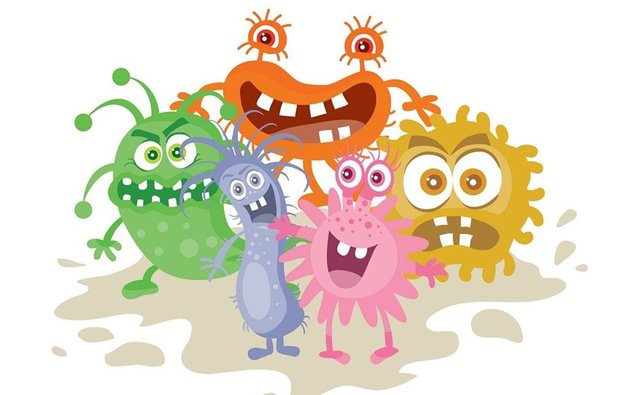Introducing The Little Guys: Microbes!

Because “protists” are so diverse, the term “protist” is no longer used. Instead, the categories of microbes are bacteria, archaea, fungi, algae, protozoa, slime molds, and viruses (because they are not cells, viruses aren’t technically living). There so many uses (such as vaccines, biofuel, and yogurt) that microbes give us, but they’re also harmful too.
Various Types of Microbes
Bacteria are unicellular, meaning that they are only one cell. Most bacteria are prokaryotic (unlike our cells, they don’t have a nucleus – they have what’s called a “nucleoid” – or many of the components of cells in animals or plants). This bacteria have a cell wall, which covers the plasma membrane of the cell. Most bacteria have this special molecule for their cell walls called peptidoglycan (big word that means “protein sugar”) that can help protect them from danger. They can live anywhere and depending on what kind of bacteria, are pathogenic or symbiotic (or helpful to us humans). These guys are microscopic. A number of them are heterotrophic (eat other organisms) or autotrophic (make their sugars by photosynthesis).
Archaea are, as far as we know, the oldest microbes. Depending on which kind of archaea, they can survive harsh treatments like high salt environments (called “halophiles”) or extreme hot temperatures (called “thermophiles”), etc. They are typically unicellular (usually prokaryotic) and have cell walls. Because they don’t have peptidoglycan, their cell walls are different from bacteria. Archaea have distinct lipids (a fancy word for a collection of fat and wax molecules) in their walls.They are microscopic. Some eat other organisms or make their own food via photosynthesis.
Fungi are eukaryotes, meaning that have the same kind of cells that we, humans, have. These cells are a lot different from bacterial, archaeal, and human cells. Fungi have a chitin (strong nitrogen-formed outer layer) cell wall*. Fungi, depending on which type, are multicellular or unicellular. Multicellular fungi are the type of fungi that grow on the forest floor. Unicellular fungi is the kind that’s used to make beer or bread.They’re either microscopic or macroscopic (macroscopic just means that we can see without looking into a microscope). Every single fungi that’s known is heterotrophic.
Algae have eukaryotic cells. They are both macroscopic and microscopic; unicellular and multicellular. They have a cell wall, but unlike bacteria and fungi, their cell wall has pectin (gelatinous polysaccharide** outer layer) or a cellulose (insoluble polysaccharide outer layer). These guys are autotrophic. They’re very important to the environment (and our survival!). They make a lot of of the oxygen we breathe!
Protozoa are unicellular eukaryotic organisms that have no cell wall and are typically microscopic and heterotrophic. Most protozoa can move and can survive in different places including the intestines of some animals!
Slime Molds are eukaryotic microbes that act like protozoa in the beginning of their life by engulfing their food and then act like fungi later in life by growing on their food.
Viruses aren’t technically living and attack a cell to use its nutrients or its resources. They are very small! Viruses insert their DNA or RNA (depending on the virus) into the cell’s DNA. Viruses have no cell wall and are acellular (meaning it’s not a cell). Bacteriophages are viruses that insert their DNA into bacteria. Bacteriophages or just phages are used in science to help cure diseases!
There are other acellular pathogens such as prions and viroids. Prions are proteins that causes other proteins to change shape and become dysfunctional. Viroids are RNA molecules that cause plant diseases!
Sources Links are provided to give you, dear reader, the full story on a specific topic.
https://www.maximumyield.com/infused-with-life-how-microbes-work-in-your-plant-growing-system/2/1064
http://www.scienceforkidsclub.com/bacteria.html
https://steemkr.com/science/@mobbs/tree-of-life-archaea-bacteria-or-eukaryota
https://alleghanytrees.com/trees/plankton-clipart-images
https://clipartuse.com/fungi-bacteria-clipart-66343
http://clipground.com/protist-clipart.html
http://earthtrust.org/futureseas/homepage/food-webs-the-future/
https://openclipart.org/detail/205972/evil-virus
Excellent. I had no idea there were so many categories for single-celled organisms. My favorite are algae because they are delicious. However, I am sure other bacteria and yeasts, etc help me taste and give flavor to food.
;) I support your love for seaweed;) Thanks for the comment!
Thank you so much @tanata madam... upvoted
Very cool 😎. I’ve always thought slime molds were interestig entities, or rather communities. Awesome info!
Thank you for sharing this information.
If viruses is not a cell then it can't multiply right? Or am I wrong I'm not sure.
Then how does it spread?
Viruses are intracellular parasites that replicate only after infecting specific host cells. Viral infection begins when proteins on the surface of a virion bind to specific receptor proteins on the surface of host cells. The specificity of this interaction determines the host range of a virus.
I see. Thank you for the explanation.
Health is wealth ..I like it good health.
Thank for sharing this post...
You got a 15.25% upvote from @steembloggers courtesy of @stratilatkryuko!
Thank you so much for using our service! You were protected from up to 20% losses!
Help us grow by delegating to us! 100sp, 500SP, 1000SP, ANY SPYou just received 26.84% upvote from @onlyprofitbot courtesy of @stratilatkryuko!
You have been defended with a 14.69% upvote!
I was summoned by @stratilatkryuko.
You got a 25.66% upvote from @edensgarden courtesy of @stratilatkryuko!
You just received a 17.32% upvote from @honestbot, courtesy of @stratilatkryuko!
